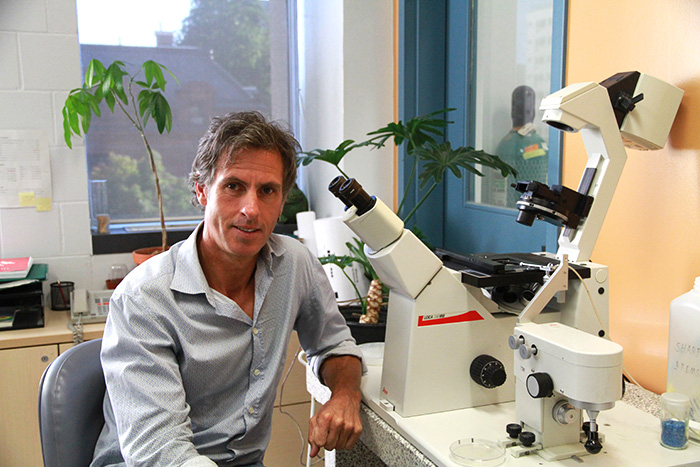Professor Richard Roy, best known for teaching the second half of the morning section of BIOL 200, administers some of the most challenging exams at McGill.
His lectures are complex and his course, demanding. While this is the reputation that precedes him, students quickly realize that it is simply a reflection of his passion for his research reflected in his lectures.
In March of 1998, Roy was chosen among numerous applicants to establish a research laboratory at McGill University.
“I got the job because of RNAi,” Roy said.
RNA interference (RNAi) is a biological process in which RNA molecules inhibit gene expression. Roy, working with Victor Ambros, an American developmental biologist, studied the effects of a then little-known gene, lin-4. Lin-4 proved to be incredibly important for larval development of the nematode, C. elegans—a worm-like creature.
Roy and his colleagues began to work on C. elegans germlines. C. elegans, under nutrient stress, will arrest development. At this point in development, the animals are still alive, yet metabolically halted, in a stage known as ‘dauer.’
This extended hibernation-like state became the focus of Roy’s laboratory. During dauer, the driving factors of metabolic processes are still present, yet inactivated. To test the factors associated with these preventative measures, Roy’s team found mutants wherein the stem cells present in the germline—the cells that could be passed on to the progeny—would not arrest, but rather continue to divide. One of these mutants had a faulty gene that encoded a protein kinase known as AMP-activated kinase (AMPK), which acts as an energy sensor.
Their lab was the first group to show that in the absence of AMPK, the germline stem cells would undergo hyperplasia—uncontrollable cell division. This is notable because stem cells are often reluctant to divide, which scientists predict is due to their need to preserve their DNA template. While the process by which AMPK acts is still unknown, Roy and his team have gone on to uncover a multitude of other functions controlled by this protein.
To fully understand AMPK, it became necessary to get a clearer view of what was controlling it. Further research showed that there are upstream regulators which are different types of proteins that can activate AMPK activity. One important regulator is liver kinase B1 (LKB1), another protein kinase. LKB1 has been identified as a very important tumour suppressor as it controls AMPK and several other similar kinases, many of which regulate cell polarity, a main factor in cancer research. So what happens when it is mutated?
“Are the phenotypic problems that arise (i.e. tumors) due to metabolic misregulation, abnormal polarity, or [is it] a combination?” Roy asked. “We are still not sure even today, but we think we are getting closer.”
Roy’s work revolves around how animals respond to environmental challenges, namely when nutrient resources are limited. Roy’s group used C. elegans as a model and noticed that the animals could not develop without food, yet were viable and motile, which indicated that something was required to block the progress of development.
They decided to remove AMPK from their C. elegans larvae and saw that those without AMPK quickly died. This signalled that AMPK was required to reallocate energy resources during famine.
However, the lab did not stop there. Roy’s team put the worms under periods of acute stress, and observed the animals when they were starved and subsequently fed. Some of the adults that had been under nutrient deprivation showed severe defects later and throughout multiple generations. AMPK was therefore necessary for the appropriate adjustment of energy resources. In its absence, the mutant animals failed to reproduce.
Roy uses the scientific process to answer important questions, not to prove a hypothesis. He stated that he revels in negative results, because they are results nonetheless.
“Science is about asking good questions and designing the right experiment to answer them,” he said. “Is it like this? If not, then why?”









